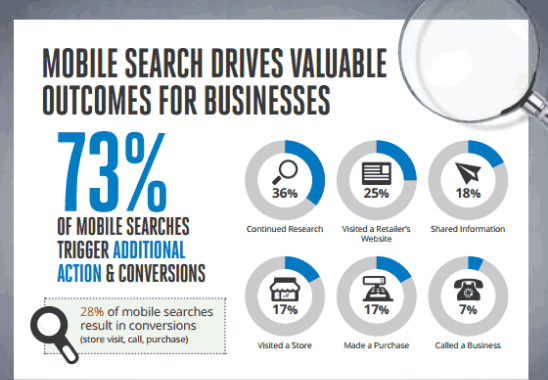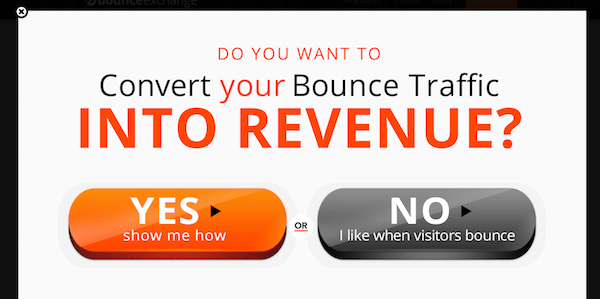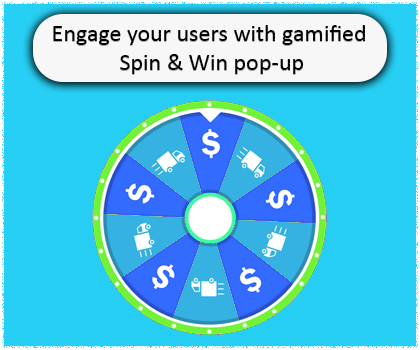Low conversion rate is something that almost every eCommerce business owner is battling. With the increase in the number of companies delving into the online trading scenario, this issue is expected to become even more prominent.
The fact is that the real killers of conversions are minor and this is why they are usually overlooked. So, before you find a solution, you need to dig deep into it’s root cause. Listed below are some of the reasons of poor conversions and the tactics for dealing with them. Let’s check them out:
Reason 1: You are missing out the chunk of mobile users
Img Source: rapidboostmarketing.com
As per a report, 73% of the mobile searches triggers additional actions. Additionally, 28% of the mobile searches result in conversions. If your eCommerce site is not mobile-responsive, then, the online shopping with a smartphone can be summed up in one word – pain. No wonder, 61% of the mobile phone users get frustrated by the shopping experience and move to the competitor’s site. In case, your website is not responsive or not mobile-tested then, you are definitely losing some chances of easy conversion.
Solution:
Make you website mobile responsive. That is, optimize your site so that contents and the images shrink automatically to fit the smaller screen size. In addition, AMP site is a natural fit for the eCommerce companies. Optimize your site as per the AMP guidelines of Google for a better browsing experience of the customers. Upgrade your desktop website into a mobile application. The mobile app builder for the various platforms like Prestashop, Magento, OpenCart and others can help you convert your site into a mobile store.
Reason 2: You haven’t optimized your content
Your web page content must add value to what you are promising to your customers. Visitors should clearly see on the landing and product pages why they should opt for you over others. One of the biggest reasons when you fall short of the desired conversions is when you are not in sync with the changing trends and the customer’s requirement. This is not it! The search queries and browsing, as well as shopping behavior of the customers, are changing with time. Earlier, the contents of the websites were focused on keywords. However, the customers these days tend to search queries instead of just keywords. The location-based searches are on the rise.
Solution:
Along with the keyword, include the long-tail queries in your content. The web contents should include the solution to the queries being searched. Moreover, the search volume of keywords like ‘Best’, ‘Top’ and others have increased. Not saying abreast with this change may be one of the reasons why your customers are not landing on your website. Go for local SEO and provide location-based solutions to the problems of your target audience. The entire content should be curated keeping in mind two questions, ‘Who is your customer?’, ‘What your customer wants?’.
Reason 3: Your CTA is not performing
The call-to-action triggers are the final sale pitch that is responsible for directing the customers to the checkout page. While the store owners might consider is just a button, it is a proven fact that even they can cripple the conversions.
Solution:
The CTA should be immediate and clearly visible to the visitors. Remove the distraction from the around the buttons. Check if the visitors are paying attention to these triggers or not. Make the necessary changes accordingly. Choose the right color combination for maximum impact. Use the low-fiction text for the same like ‘Check out’, ‘Get’, ‘Earn’ and others. Create options and do split testing to get the right solution.
Reason 4: The pop-ups are annoying
The conversion is not only affected by the amount of traffic you are getting on the website. The customer retention is another key aspect. The average session duration of a shopping site is just fringes of seconds. User often leaves a web page in 10-20 seconds. This is when the exit-intent pop-ups come into play. It might sound conventional, but it actually works. In fact, this is one of the most converting elements of a website. However, making the scroll bars or exit pop-ups intrusive can kill your site’s performance. Being too aggressive while curbing the exit intention of your site visitor can, in fact, affect the conversions adversely.
Solutions:
The very first trick to reduce the negative impact of the same is to test the pop-ups before making it live. A/B testing can help you find the exact effect it’ll have on your visitors. The pop-ups with aggressive messages like “No, I don’t traffic on my website and” can give a wrong message. Keep the tone of the messages displayed positive.
In addition, gamified exit pop-ups such as spin and win can really keep your visitors engaged for a longer duration. The more time they spend on your site, the better are the chances of conversions.
Reason 5: You are not redirecting the visitors to the checkout page
Right from poor landing pages to the lengthy checkout procedure, everything is an aspect of the inefficient conversion funnel. Only a seamless shopping experience can redirect the visitors to the payment gateway. In case, the customers are landing on your website, but are not converting into paying leads, then, probably you are redirecting them properly throughout the transaction.
Solution:
A poor landing page is probably the first in the list that is responsible for a low conversion rate. Make sure that you focus on the visual merchandising of the category pages. Proper navigation and filters can help the customers land on the desired product page. This also includes using A/b testing tools that create landing pages on the fly with very little effort. The product page should be optimized and informative enough to present your sales pitch in the best possible way. High-definition images and product videos can provide the customers with the much required clarity. Product tab module which creates information tabs on the product page is one of the ways to make optimum use of the limited space. Once the customer clicks on the ‘Buy Now’ button ensure a flawless transaction. Instead of making it a long and tedious job, go for the one page checkout.
Conclusion
Proper tracking can make a world of difference to your conversion rate. Learn to counter your mistakes from the brick-and-mortar store and focus on the minor changes that are required to deal with low conversions.
Related Stories:
- 5 Quickfire Prestashop Addons that can Boost your Conversions
- 5 Solid Evidence a Facebook Store can double your Conversions
- 5 Tips to avoid abandoned carts and win conversions through emails
- 5 Ways Exit Popup can help Boost your eCommerce Conversions
- 5 Ways Prestashop Spin & Win Module can boost your Conversions





